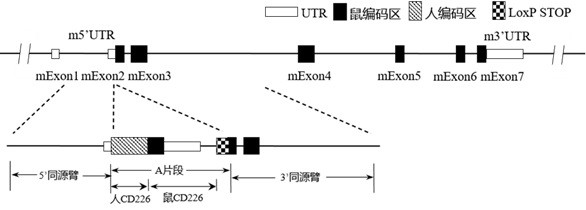Construction method and application of CD226 gene-humanized non-human animal
A CD226, non-human animal technology, applied in chemical instruments and methods, botanical equipment and methods, biochemical equipment and methods, etc., can solve problems such as gene complexity
- Summary
- Abstract
- Description
- Claims
- Application Information
AI Technical Summary
Problems solved by technology
Method used
Image
Examples
Embodiment 1
[0121] Example 1 CD226 Gene Humanized Mice
[0122] Mouse CD226 gene (NCBI Gene ID: 225825, Primary source: MGI: 3039602, UniProt: Q8K4F0, located at positions 89176954 to 89272232 of chromosome 18 NC_000084.6, based on the transcript NM_178687.2 and its encoded protein NP_848802.2 ( SEQ ID NO.1)) and human CD226 gene (NCBI Gene ID: 10666, Primary source: HGNC: 16961, UniProt ID: Q15762, located at positions 69853274 to 69962086 of chromosome 18 NC_000018.10, based on transcript NM_006566.4 and its encoded protein NP_006557.2 (SEQ ID NO.2)) comparison diagram as shown figure 1 shown.
[0123] In order to achieve the purpose of the present invention, the nucleotide sequence encoding human CD226 protein can be introduced into the mouse endogenous CD226 gene locus, so that the mouse expresses human or humanized CD226 protein. Specifically, using gene editing technology, under the control of the regulatory elements of the mouse CD226 gene, the partial sequence of exon 2 to exon ...
Embodiment 2
[0168] Example 2 Preparation of double humanized or multiple double humanized mice
[0169] Double-humanized or multihumanized mouse models can also be prepared by using the method or the prepared CD226 mice. For example, in the aforementioned Example 1, the embryonic stem cells used in the microinjection of blastocysts can be selected from mice containing other genetic modifications such as PD-1, PD-L1, and TIGIT, or they can also be derived from humanized CD226 mice Based on the isolation of mouse ES embryonic stem cells and gene recombination targeting technology, a double-gene or multi-gene modified mouse model of CD226 and other gene modifications was obtained. The homozygous or heterozygous CD226 mice obtained by this method can also be mated with other genetically modified homozygous or heterozygous mice, and their offspring can be screened. According to the Mendelian law of inheritance, there is a certain probability of obtaining humanized CD226 Heterozygous mice with o...
PUM
 Login to View More
Login to View More Abstract
Description
Claims
Application Information
 Login to View More
Login to View More - R&D Engineer
- R&D Manager
- IP Professional
- Industry Leading Data Capabilities
- Powerful AI technology
- Patent DNA Extraction
Browse by: Latest US Patents, China's latest patents, Technical Efficacy Thesaurus, Application Domain, Technology Topic, Popular Technical Reports.
© 2024 PatSnap. All rights reserved.Legal|Privacy policy|Modern Slavery Act Transparency Statement|Sitemap|About US| Contact US: help@patsnap.com










